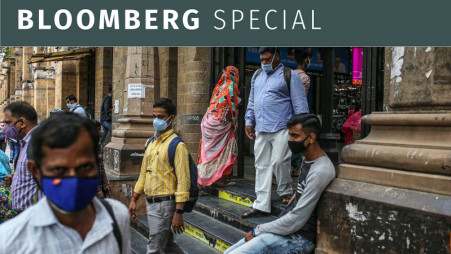Why India’s world-beating growth isn’t creating jobs
The unemployment rate in India has been hovering around 7% or 8%, up from about 5% five years ago, according to the Centre for Monitoring Indian Economy,

No other major economy has been expanding as fast as India lately, beating both China and the US. But beyond the headlines lies the grim reality of rising unemployment. The nation of 1.4 billion people isn't creating enough jobs for its growing workforce, despite campaign promises by Prime Minister Narendra Modi to make it a priority.
Output is increasing as a result of pandemic-related government spending while the private sector sits on the fence, deterred by dim conditions for new investment. Meanwhile, pandemic-related disruptions and rising inflation are making it harder for everyone to get by. Tensions boiled over in June when angry youth facing bleak job prospects blocked rail traffic and highways in many states for days, even setting some trains on fire.
1. How bad is the jobs situation?
The unemployment rate in India has been hovering around 7% or 8%, up from about 5% five years ago, according to the Centre for Monitoring Indian Economy, a private research firm. At the same time, the workforce shrank as millions of people dejected over weak job prospects pulled out, a situation that was exacerbated by Covid-19 lockdowns. The labor force participation rate -- meaning people who are working or looking for work -- has dropped to just 40% of the 900 million Indians of legal age, from 46% six years ago, according to the CMIE. By comparison, the participation rate in the US was 62.2% in June.

2. Who's most affected?
Women and the young. Between 2010 and 2020, the number of working women in India dropped to 19% from 26%, according to data compiled by the World Bank. As Covid infections surged, a bad situation turned dire: CMIE estimated that female labor force participation plummeted to 9% by 2022 -- putting it in the same league as war-torn Yemen. Rosa Abraham, an economics professor at Azim Premji University in Bengaluru, who tracked more than 20,000 people before and after India's first pandemic lockdown in 2020, found that women were several times more likely to lose their jobs than men and far less likely to recover work after restrictions lifted. At the same time, young people are finding it harder to get jobs. CMIE estimated the unemployment in the 20-24 age group was 43.7% in June. That compares with 18.4% in May for the 16-24 category in China, which is also facing a worsening crisis.
3. What's behind those numbers?
India's poor system of education and job-training means degrees are often considered worthless by employers. In large-scale surveys, employers have said that less than half the college graduates entering the workforce have the cutting-edge skills they need or the ability to pick them up in the workplace. So many would-be job seekers decide instead to continue their studies, join family members in farming or just stay home, surviving on rental income, pensions received by elderly household members or government transfers. Many women are opting for unpaid work at home, taking care of elderly relatives and kids.
4. Why is this a cause for concern?
India has the advantage of youth -- half the population is under 30 -- but it will start aging in coming decades. If it gets old before it develops and gets rich enough to support everyone, that would have repercussions for the $3.2 trillion economy. To sustain world-beating growth and woo global investors, Modi needs to ensure there's a trained workforce for industry to draw on. There's also the potential for social unrest, as illustrated by the protests that erupted in June over a new military recruitment plan that offered shorter contracts and fewer benefits. India needs to create at least 90 million new non-farm jobs by 2030, according to a 2020 report by McKinsey Global Institute.
5. What's the government doing?
It has announced plans to hire a million people by the end of 2023 to fill vacancies in government departments. The program to enlist young men as soldiers on four-year contracts lured a record number of applicants in its first weeks, despite the backlash from some quarters. The government says the program will help boost employment by supplying a trained, disciplined workforce to local industry. Private sector jobs that are mushrooming are mainly in the gig economy, such as drivers for Uber Technologies Inc. or delivery workers for Zomato Ltd. To create jobs on a mass scale India needs to boost manufacturing and that hinges on creating infrastructure, removing red tape and reviving investor sentiment. With national polls barely two years away, Modi's opponents have started talking about a labor market crisis.

6. Why not use government data?
The government in April cited what it called "authentic data" from the Statistics Ministry showing the labor market recovering. But economists have described those figures as outdated and inadequate. For starters, they come with a lag of one year: Official data for the year ending June 30, 2021, was only released in June 2022. And it showed the unemployment rate fell to 4.2% that year, down from an official 4.8% -- despite harsh Covid lockdowns and an economic slowdown. Markets and academicians prefer to rely on the survey-based unemployment data from CMIE as it's more timely and correlates better with ground realities. The government has started some new efforts to get data directly from businesses, and is working on more surveys aimed at the so-called informal sector, such as migrant laborers and domestic workers, which covers 75% of the workforce.
Disclaimer: This article first appeared on Bloomberg, and is published by special syndication arrangement.



 Keep updated, follow The Business Standard's Google news channel
Keep updated, follow The Business Standard's Google news channel
















